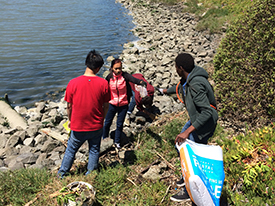 We gathered on a beautiful Saturday morning at Berkeley’s Shorebird Park Nature Center to learn more about the San Francisco Bay, and lend a hand for the shoreline cleanup. City of Berkeley staff member Loren began with a brief history of the Bay, reminding us of a previous proposal to fill it in entirely! Due to the tremendous work of Save the Bay, environmental activists halted that plan from happening. The Berkeley Marina is geographically oriented directly across from the Golden Gate, which is the access point for the tides that refresh the waters of the Marina. The Marina’s ecology is heavily impacted by litter and debris, most of which is plastic. Litter collects at the Marina from both our urban environment and the tidal currents – 80% of marine debris come from land–based sources, including litter that washes from our creeks and storm drains.
We gathered on a beautiful Saturday morning at Berkeley’s Shorebird Park Nature Center to learn more about the San Francisco Bay, and lend a hand for the shoreline cleanup. City of Berkeley staff member Loren began with a brief history of the Bay, reminding us of a previous proposal to fill it in entirely! Due to the tremendous work of Save the Bay, environmental activists halted that plan from happening. The Berkeley Marina is geographically oriented directly across from the Golden Gate, which is the access point for the tides that refresh the waters of the Marina. The Marina’s ecology is heavily impacted by litter and debris, most of which is plastic. Litter collects at the Marina from both our urban environment and the tidal currents – 80% of marine debris come from land–based sources, including litter that washes from our creeks and storm drains.
Following our discussion, the group headed down to the shoreline, where we picked up debris and tracked our findings on data cards. The data cards are shared with the Coastal Commission, and act as a tool for identifying problems, or as a catalyst for inspiring future legislation. We carried buckets and other supplies and divided into small groups. One person acted as a note taker, others focused on cleaning debris. For each piece of debris, we added a tally to our notes, categorizing the different types of waste we found. Throughout the day we collected two categories of debris: garbage (plastic bags, bottle lids, pens, wrappers, etc) and recyclables (bottles, cans). Some of the debris was quite large, like a 33 gallon garbage can, but the majority was smaller and only revealed itself gradually, following close inspection. The area that we worked at was covered in riprap – the large, uneven stones used to stabilize the shoreline. Over time, many bags and other flexible items have found their way between these large stones. We spent around an hour and a half dislodging and removing the debris from the crevices before returning to the Nature Center. The Marina was filled with people practicing Tai Chi, celebrating birthday parties, practicing stage combat, and barbecuing, all enjoying the natural beauty of the shoreline.
Back at the Nature Center, we tallied the data cards, finding that we had collected 2028 items, 87% of which were single–use plastic products or pieces of plastic. This is a rewarding total for a few hours’ effort – but there will always be more to clean up until we are able to reduce consumption of these plastics. There are some types of plastic that can’t even be cleaned up at all, like plastic microbeads – tiny, abrasive plastic balls used in many personal care products, such as face washes and body scrubs. These microbeads are so small that they are able to pass through the water treatment system and make their way into the ocean. The microbeads are also mistaken for food by aquatic life, and are eaten to the detriment of many sea creatures. Furthermore, the microbeads attract and absorb toxins, and become increasingly harmful over time! Some products mention microbeads on their labels, while others will list the following: polyethylene (PE) or polypropylene (PP), polyethylene terephthalate (PET), polymethyl methacrylate (PMMA) or nylon.
What else can we do about this tiny, toxic form of pollution? You can sign the petition proposing to Ban the Bead on the Story of Stuff’s website: storyofstuff.org/plastic-microbeads-ban-the-bead
To spread the message that we don’t need this plastic in our lives, we’re also hosting a Do-It-Yourself Body Product workshop this Sunday, July 26 at the Ecology Center! Ecology Center staffer Jeannie Pham will be teaching us how to make two items — a facial scrub and a toothpaste — using natural alternatives to microbeads. Register here.



